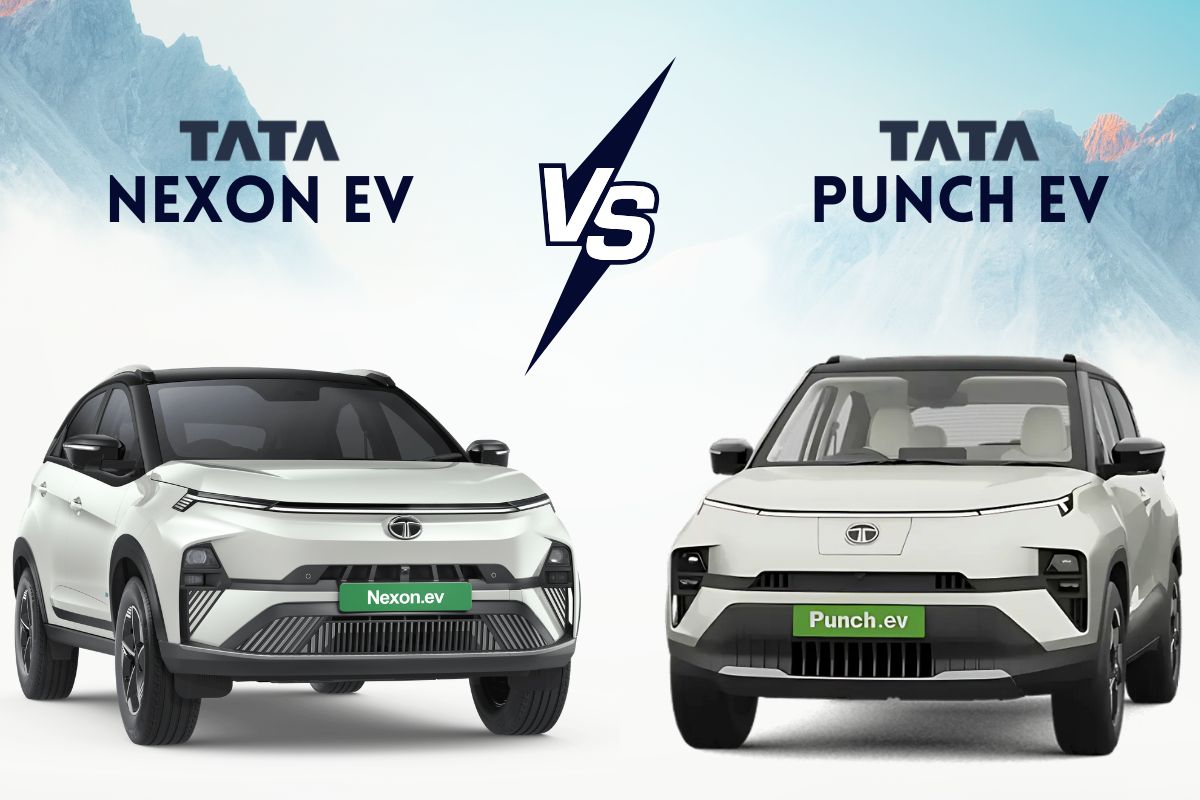


Tata Motors has created a solid reputation in India’s electric vehicle space, offering EVs that blend affordability, modern features, and real-world practicality. Among its top offerings, the Tata Nexon EV and Tata Punch EV stand out for different reasons. One leans towards power and presence, while the other focuses on compact versatility and efficiency. If you are comparing the two, this blog will help you understand how they differ and which one better fits your needs.
Table of Contents
ToggleThe design language of both vehicles is distinctly futuristic, but the presence they command is quite different.
The Tata Nexon EV looks more assertive on the road. Its taller profile, LED light signature, and coupe-inspired roofline give it a grown-up SUV identity. The design is bold and feels mature, making it suitable for those who prefer a more assertive look.
Tata Punch EV has a more youthful vibe. It is a micro-SUV, but Tata has smartly sculpted its panels to give it a sturdy character. Details such as sequential indicators, gloss accents, and a sculpted bonnet add to its urban appeal.
Also read: How to Use Yoga For Stress Relief: An Easy Guide to Follow
Inside, both models feature clean layouts with a smart use of space, although they are aimed at different audiences.
The Nexon EV has a more spacious cabin. It has a leatherette finish, ventilated front seats, dual screens on higher variants, and features like a front armrest and rear AC vents. It feels more comfortable for long journeys.
The Tata Punch EV brings in fresh elements. Its digital cockpit, phygital climate controls, and illuminated glove box offer a fun, tech-forward experience. The 90-degree opening doors are a big help for elderly passengers or tight parking spaces.
You might expect the larger car to have the bigger boot, but that’s not the case here.
Punch EV surprises with a 366-litre boot space, which is more than the Nexon EV offers. The frunk adds another handy storage spot for cables or bags.
Despite its size advantage, the Nexon EV provides 350 litres. Still, it makes up for that with better rear seat legroom and an overall roomier cabin feel.
Performance is a defining factor for many EV buyers, and this is where the cars start to show distinct personalities.
The Nexon EV, especially the long-range version, has 106.4 kW of power and 215 Nm of torque. It accelerates quickly and handles highway speeds confidently. If you want a quick and stable drive, this one fits the bill.
The Punch EV’s long-range variant offers 90 kW of power with 190 Nm torque. It’s not as quick off the line but makes for a nimble, city-friendly drive that’s easy to control in traffic.
Both models are built to tackle daily drives, with more than enough range for typical commutes.
Nexon EV LR provides up to 465 km on a single charge under standard conditions. Charging via a 7.2 kW AC charger takes around 6.5 hours, while a DC fast charger does 10 to 80 percent in about 56 minutes.
Punch EV LR delivers a certified range of up to 421 km. Thanks to its smaller battery, full charging takes slightly less time. It also supports fast DC charging, matching the Nexon’s time for partial top-ups.
Tata has equipped both models with modern infotainment platforms, but the experience differs slightly.
Nexon EV features a larger 31.24 cm screen with JBL speakers in top trims. The digital driver display adds a futuristic feel. Navigation, music, and app-based entertainment are available through the Arcad. Ev suite.
Punch EV uses a 26.03 cm infotainment system paired with a sharp digital cockpit. It supports the same voice assistants as Nexon and also offers wireless smartphone charging and navigation support.
Tata has made safety a priority in both these vehicles, and it shows in the results.
Nexon EV has received a 5-star Bharat NCAP rating. It comes with six airbags, an electronic stability program, hill hold, and advanced braking tech. Top variants also get a 360-degree camera and blind spot detection.
Punch EV offers equally impressive credentials. It also holds a 5-star rating and includes six airbags, all-disc brakes, ISOFIX, and hill control features.
Also read: PM Awas Yojana Gramin
Both the Tata Nexon EV and Tata Punch EV bring serious value. If your daily travel includes longer trips and you prefer extra power and cabin space, the Nexon EV is the clear winner. For those living in crowded cities who want a smart, compact car that doesn’t compromise on features, the Punch EV is hard to ignore.
The right choice depends on your life behind the wheel. Consider your routes, space needs, and comfort expectations. Once you do that, the better pick will stand out naturally.

